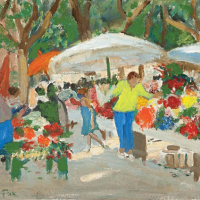25. ETHEL CARRICK FOX

Ethel Carrick Fox was an immensely successful artist in the first half of the twentieth century, exhibiting widely in Australia, England and France for almost fifty years. She was an active member of the creative community. For instance, she was made a Socitaire of the Salon dAutomne in 1911, and joined the jury in 1912, the same year she was elected vice-president of the Womens International Art Union in Paris. Carrick Fox also dedicated her time to the wider community, such as fundraising for the Red Cross both in the first and second World Wars. She also became a Theosophist, a movement which provided an international network for free-floating but respectable women, who were primarily educated and middle-class.1
Born in 1872 in Uxbridge, England, Carrick Fox came to art relatively late, beginning private lessons with Francis Bate (1858-1950) in 1895, and entering the London Slade School of Art in 1897, where she studied under Henry Tonks (1862-1937). While visiting the popular artist colony at St Ives around 1901, she met the Australian artist Emanuel Phillips Fox (1865-1915), who had been living in Europe since 1887. The couple married in 1905 at St Peter's Church, Ealing, before moving to the artistic area of Montparnasse in Paris. In 1908, Carrick Fox made her first trip to Australia, maintained a strong relationship with her husbands homeland even after he died in 1915. She travelled constantly: to Australia, France, Switzerland, Belgium, Italy, England, Majorca, Egypt, Morocco, Tunisia and India.
Choosing a Bouquet shows a woman at an outdoor market looking at the colourful rows of flowers displayed beneath white umbrellas. This is a familiar subject in Carrick Foxs oeuvre by 1930, she had spent almost three decades studying everyday life in public spaces, such as gardens, beaches and markets, painting people-especially women and children-going about their lives, seemingly unaware of her gaze. Choosing a Bouquet shows her interest in exploring colour and form, capturing a distinct moment in time. The bold splashes of colour in the bunches of flowers are echoed by the bright yellow of the womans shirt, immersing her in the space. Carrick Fox explained that it's people who attract me. Crowds are to me what a magnet is to a needle. I love the colour, life, movement, and individuality of a crowd. It's rather unfortunate, as I hate noise, but my private feelings have no chance against the compelling charm of a mass of people.2
Her subject matter and style made her images popular with critics and buyers. A review of her Sydney exhibition in 1913 praised her work as one feels always the presence of a personality imbued with a genuine sense of harmony, something of a genius for composition, and an imagination coloured by a passionate feeling for what is most beautiful in the visible world.3 Twenty years later, another reviewer wrote that the obvious aim of the artist has been to express the aesthetic essence of her subject in pattern and colour harmonies, rather than by direct representation of its individual elements, and having chosen this path she has followed it faithfully and with a considerable measure of success.4
Carrick Foxs work is widely represented in museums, galleries as well as private collections, in Australia and abroad. This includes the National Gallery of Australia, Canberra, most state galleries and also many regional galleries. There has been persistent interest in Carrick Foxs art and life, and she has been the subject of exhibitions, including Ethel Carrick (Mrs. E. Phillips Fox): A Retrospective Exhibition (1979), Capturing the Orient: The Works of Ethel Carrick Fox and Hilda Rix Nicholas (1993) and Art, Love and Life: Ethel Carrick and E Phillips Fox Exhibition (2011).
Footnotes
1. Roe,J., Beyond belief: Theosophy in Australia 1879-1939, Kensington, New South Wales University Press, c1986
2. Distinguished Woman Artist, The Sun, 9 November 1913, p.19
3. Pictures for the Home, The Sydney Morning Herald, 7 November 1913, p.7
4. The Art of Ethel Carrick, The Age, 24 May 1933, p.10
Dr Kate Robertson, PhD University of Sydney